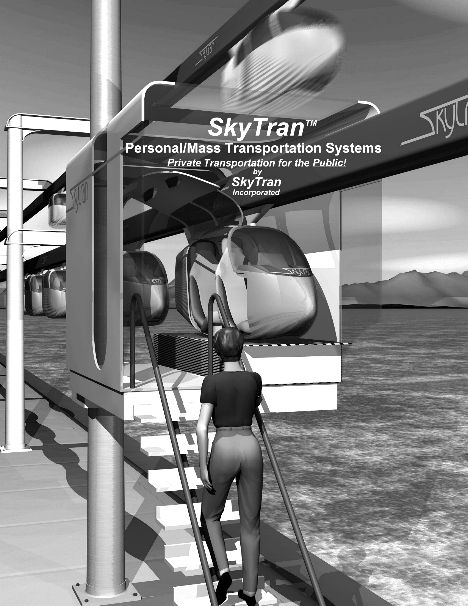|
Recent
Articles about SkyTran
This concise article by Jerry Spellman
of Mesa, Arizona appeared in the Arizona Tribune, June 3, 1999.
|
OPINION 2
THE TRIBUNE, THURSDAY. JUNE 3, 1999 |
Public
transit:
How
do we go from here? |
Light
rail
no match
for
SkyTran
BY
JERRY SPELLMAN
SPECIAL
TO THE TRIBUNE
Can
you picture a day when Valley
commuters will be able to zip
around town at 100 mph in
streamlined, spaceage personal
transit vehicles that don't
pollute, don't waste energy and
cost a fraction of what a light
rail and expanded bus system
will cost?
The
new, revolutionary transit
system is called SkyTran.
It's
revolutionary because it takes
the best features of
state-of-the-art systems like
magnetic levitation, automation,
electronics and robotics and
blends them together to provide
a transit alternative that is
not only super fast, but
convenient, comfortable, safe
and affordable, all at the same
time.
This is
not science fiction, folks, this
is science fact!
SkyTran
is a concept developed by a
California scientist named Doug
Malewicki who has invented
numerous vehicles that integrate
the latest transportation
technologies and aerodynamic
designs including the California
Commuter (a single- passenger
road vehicle that holds two
Guinness World Records for
energy efficiency) and the
popular "Robosoarus"
car-eating, fire-breathing
dinosaur that appears regularly
at monster truck shows to the
delight of young and old, and
car lovers and haters
alike. |

Brad T. Bowman/SkyTran
|
Another
feature that makes the SkyTran
personal/mass transportation
system so special is that
vehicles are available
"on-demand," meaning
there is no waiting, or
schedule, or even driver for
that matter. A passenger simply
boards the first vehicle in a
line of vehicles always ready at
each transit stop, keys in a
destination on the on-board
computer, and is whisked off non-stop
to it. |
|
Some
of the features that make SkyTran such an
innovative and remarkable transit concept are
its lightweight, tandem, two-passenger vehicles,
its streamlined and minimalist guiderail support
structures and. stations, and its ability to
move passengers in three dimensions.
The SkyTran vehicles
hang suspended from overhead guiderails which
allow the vehicles to travel either at ground
level or above traffic and to turn or move from
ground level to above traffic in a very brief
time and short space.
Another feature that makes the SkyTran
personal/mass transportation system so special
is that vehicles are available
"on-demand," meaning there is no
waiting, or schedule, or even driver for that
matter. A passenger simply boards the first
vehicle in a line of vehicles always ready at
each transit stop, keys in a destination on the
on-board computer, and is whisked off non-stop
to it.
SkyTran vehicles operate in their own safe
environment, separate from pedestrian and
surface vehicle traffic, and never have to stop
for traffic lights, stop signs or railroad
crossings because there are no |
intersections
where vehicles and/or pedestrians can collide.
SkyTran employs a
passive magnetic levitation merging system,
similar to freeway cloverleaf interchanges, and
fail safe electronic monitoring devices and
sensors to keep system vehicles safe distances
apart.
The benefits of SkyTran are
numerous, especially when compared to other
transit modes like light rail and buses. One
mile of SkyTran guiderail, including stations
and stops, will cost $1 million to $2 million.
(Light rail costs $25 million to $50 million per
mile.) SkyTran vehicles will cost approximately
$4,000 to $6,000 each (One new 36-passenger
transit bus costs $300,000.)
SkyTran labor, operating and maintenance costs
are only a fraction of those required to support
a light rail and expanded bus system since there
are no drivers. SkyTran magnetically levitated
vehicles run on electricity (equivalent to 200
miles-per-gallon energy utilization) and the
maglev propulsion system has no moving parts
that wear out (there is no friction).
|
Also,
consider the savings not only in terms of the
tax burden current transit systems put on the
public but in other areas such as no land
purchases or neighborhood destruction to provide
rights-of-way. No air or noise pollution, no
parking lots or garages needed, no traffic jams
or accidents or road rage, and all the extra
time and money you'll have from not
having to work so hard to own and support two or
three vehicles per, family.
Compare SkyTran to the proposed Valley
Connections plan for light rail and expanded bus
service, which would cost about $3 billion over
10 years to construct, operate and maintain. If
we spent the same amount developing a SkyTran
system, we could have 1,200 miles of guideway
and 200,000 vehicles rather than 35 miles of
light rail and 500 more buses on our crowded
streets.
But don't just take my word for it. Do the math
yourself and check out the SkyTran Web site
(http://www.SkyTran.net). Then call the
governor, your mayor, senator and congressperson
and tell them to stop wasting your tax dollars
on obsolete transit solutions.
Jerry Spellman has lived in the East Valley
for 20 years. |
|
to read the July 16,
1999 article about SkyTran in the Arizona REPUBLIC


to PRESS Contents
|
![]()